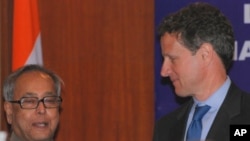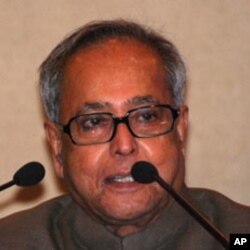The U.S. treasury secretary and India's finance minister have kicked off what they are calling a new economic and financial partnership between the two countries.
U.S. Treasury Secretary Timothy Geithner was hosted by Finance Minister Pranab Mukherjee at the first meeting of the partnership.
During a brief news conference afterwards, Geithner spoke of the potential for cooperation between the two giant economies, but he was short on offering specifics.
"We're at a time of great optimism in the United States and around the world about the prospects for growth and reform in India," he said. "And I think we have a chance to demonstrate together that this economic relationship offers very promising growth and opportunities for American firms just as it does for Indian firms."
Mukherjee suggested opportunities for American investment in India's booming infrastructure expansion. "In a five-year period more than 600 billion U.S. dollars could be invested in ports, in roads, in communications," he said.
Both officials steered clear of mentioning China or its currency policy, which is under intense international scrutiny.
The U.S. Treasury Department has delayed a report it had been scheduled to release next week which will make a determination on whether Beijing is manipulating its currency, the yuan.
Geithner, who spent five years of his childhood living in the Indian capital, is on his first trip to the country as Treasury secretary. He is to meet with business leaders in the country's commercial capital, Mumbai, on Wednesday.
Geithner met with Indian Prime Minister Manmohan Singh after visiting a mobile banking site in New Delhi Tuesday morning.
Domestic media reports say the visiting U.S. official asked Indian leaders for greater access to financial services markets, such as insurance.
While relations have warmed between Washington and New Delhi in recent years, efforts to reach economic accords between the two democracies have always been difficult. Their disagreements, especially about the agricultural sector, are blamed for leading to the scuttling in 2008 of global trade negotiations.
Despite the differences, American investment in India has been expanding - increasing by ten times during the past decade while total two-way trade during that time frame has tripled.









